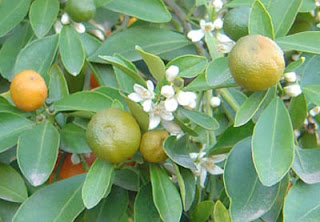Small citrus fruit resembling a miniature tangerine. Fruits are very juicy, with a sweet but acidic flavor. Common in tropical zones, but lesser known elsewhere.
Description
Small tree, from 6-25ft in height. Leaves are smaller than most citrus. May take on a bushier appearing growth habit than some other citrus.
Hardiness
The calamondin is hardy to temperatures in the mid 20's. It can be successfully grown outside throughout California, Florida, and the gulf coast. It makes an excellent container plant in colder areas.
Trees grow well in full-sun and enjoy regular irrigation, though less so during cold months. Grow in well-drained soil. While fertilizing in sometimes unnecessary, trees can be fertilized on the same schedule as other citrus.
Propagation
Often by seed, (unlike some other citrus). Seeds are polyembryonic and may produce up to 3-5 seedlings each. Commercial growers propagate the calamondin by cuttings which bear fruit in just two years.
Uses
Eaten raw, although the flavor is very acidic. Often used to flavor drinks, jellies, and a variety of foods.
Native Range
Native to China. Has now spread throughout much of the South Pacific and the Americas.





No comments:
Post a Comment